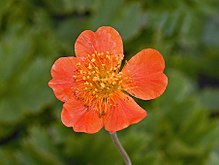| Geum coccineum | |
|---|---|

| |
| Flower of Geum coccineum at the Giardino Botanico Alpino Chanousia | |
| Scientific classification | |
| Kingdom: | Plantae |
| Clade: | Tracheophytes |
| Clade: | Angiosperms |
| Clade: | Eudicots |
| Clade: | Rosids |
| Order: | Rosales |
| Family: | Rosaceae |
| Genus: | Geum |
| Species: | G. coccineum |
| Binomial name | |
| Geum coccineum Sibth. & Sm. | |
Geum coccineum is a species of flowering plant in the genus Geum, in the rose family Rosaceae. Native to the mountains of the Balkans and northern Turkey, it is also grown ornamentally for its bright red flowers.
Nomenclature
In horticulture, it is also referred to as Geum borisii, but in the botanical literature following J. Kellerer & Sünd. this name is only used for the hybrid Geum bulgaricum × montanum. The name Geum coccineum is itself used in the gardening literature for another related plant: Geum chiloense Balbis..
Description
Geum coccineum is herbaceous and perennial, growing to a height of 10–45 cm. It blooms, with orange-red flowers, from May to August.
The species is hexaploid (with 2n=42), having six sets of chromosomes.
Distribution and habitat
The plant is found on wet, marshy meadows and along streams.
Within Turkey, the plant is found at elevations of 1200–2400 m in a number of localities in the Pontic Mountains (including Karagöl in the province of Gümüşhane, Zigana in Trabzon, and Cimil in Rize), in the Erzurum area, in the Ilgaz Mountains of Kastamonu Province, Murat Dağ [tr] in Kütahya, and Uludağ (Bithynian Olympus) in the province of Bursa.
Geum coccineum grows in the mountains of Bulgaria (at elevations of 900–2300 m in the western and central Balkan Mountains, on Vitosha, Verila, Sredna Gora, Osogovo, Rila, Pirin, Slavyanka, and the western and central Rhodopes), Serbia (the Balkan Mountains), North Macedonia, and central Bosnia and Herzegovina. It is also present in the Accursed Mountains of Albania and Montenegro, in the mountains of eastern Albania, and northern Greece (at 1300–2000 m in northern Pindus and mountains of Greek Macedonia: Varnous, Vitsi, Pieria, Vermio, Piperitsa, Kajmakčalan and Tzena).
It is grown decoratively (with several cultivars), and as a garden escapee it has become naturalised in isolated areas of Slovenia and Saxony.
References
- ^ Kurtto, Arto; Lampinen, Raino; Junikka, Leo (2004). Atlas florae Europaeae, distribution of vascular plants in Europe. 13: Rosaceae (Spiraea to Fragaria, excl. Rubus). Helsinki: Committee for mapping the flora of Europe and Societas Biologica Fennica. pp. 144–45. ISBN 978-951-9108-14-8.
- ^ Persson, J. (1986). "Geum L.". In Strid, Arne (ed.). Mountain flora of Greece. Cambridge University Press. pp. 404–5. ISBN 978-0-521-25737-4.
- "Geum coccineum Lindl". World Flora Online. Retrieved 18 December 2021.
- ^ Peşmen, H.; Chamberlain, D.F. (1972). "Geum L.". In Davis, P.H. (ed.). Flora of Turkey. Vol. 4. Edinburgh University Press. pp. 71–72. ISBN 0852242085.
- May-July (Peşmen & Chamberlain 1972 for Turkey); May-August (Asenov 1973 for Bulgaria); mid-June to early August (Persson 1986 for Greece).
- Asenov 1973, Persson 1986. Damp forests also mentioned in Peşmen & Chamberlain (1972).
- Asenov, I. (1973). "Omajniče – Geum L.". In Vǎlev, Stoju; Asenov, Ivan (eds.). Flora na Narodna Republika Bǎlgarija (in Bulgarian). Vol. V. Sofia: Bulgarian Academy of Sciences. p. 198.
- Gajić, M. (1972). "Rod Geum L.". Flora SR Srbije (in Serbian). Vol. 4. Beograd: Srpska Akademija Nauka i Umetnosti. p. 76.
- Caković, Danka; Stešević, Danijela (2021). Katalog vaskularne flore Crne Gore (in Montenegrin). Vol. II. Podgorica: Montenegrin Academy of Sciences and Arts. p. 159. ISBN 978-86-7215-488-7. This only mentions Montenegro (Bogićevica + central and north-eastern Prokletije). Even though such a delimitation strongly suggests presence in Kosovo, this is not mentioned in Gajić (1972). From Atlas Florae Europaeae it is not clear if Kosovo is to be included, but the Albanian side of Prokletije falls visibly within the plant's native range.
| Taxon identifiers | |
|---|---|
| Geum coccineum |
|